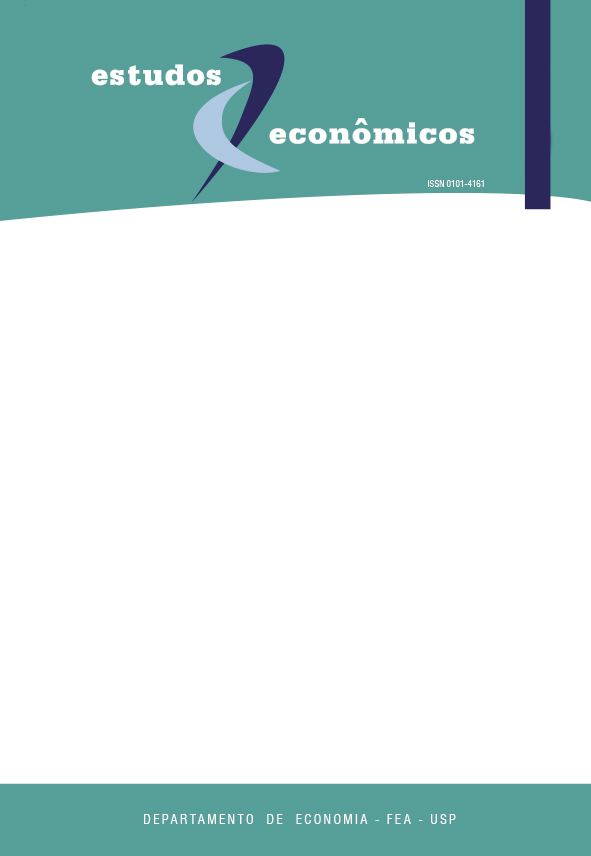Os efeitos dos choques reais e nominais sobre as taxas de câmbio no Brasil
DOI:
https://doi.org/10.1590/S0101-41612010000300002Palavras-chave:
taxas de câmbio, choques reais e nominais, efeitos permanente e temporárioResumo
Este artigo analisa os impactos dos choques reais e nominais sobre as taxas de câmbio real e nominal entre Brasil e Estados Unidos no período de 1999 a 2007. O objetivo principal é estudar o comportamento das taxas de câmbio real e nominal em direção ao equilíbrio de longo prazo e como essas taxas podem ser decompostas em movimentos causados por choques reais e nominais. Os resultados mostraram que ambas as taxas de câmbio respondem de imediato a um choque nominal, ocorrendo o fenômeno de overshooting. O efeito de um choque nominal sobre a taxa real de câmbio é apenas temporário, enquanto, sobre a taxa nominal, é permanente. Quando submetidas a choques reais, ambas as taxas de câmbio "saltam", ultrapassando seus níveis de equilíbrio de longo prazo, para retornarem a esse equilíbrio em aproximadamente 25 meses. Novamente se observa o fenômeno de overshooting e que esses efeitos sobre as taxas de câmbio são de caráter permanente.
Downloads
Referências
ABRAS, A. L. G.; SEKKEL, R. M. Choques nominais e reais na taxa de câmbio: evidência
empírica para o Brasil pós desvalorização de 1999. Disponível em:
www.anpec.org.br/encontro2003/artigos/c48.pdf>. Acesso em: 31 ago. 2007.
BLANCHARD, O.; QUAH, D. The dynamic effects of aggregate demand and supply disturbances. American Economic Review, v. 79, p. 655-673, Sep. 1989.
CLARIDA, R.; GALÍ, J. Sources of real exchange rate fluctuations: how important
are nominal shocks? Carnegie - Rochester Series on Public Policy, v. 41, p. 1-54, 1994.
CHOI, C. Y.; MARK, N. C.; SUL, D. Unbiased estimation of the half-life to PPP
convergence in panel data. Journal of Money, Credit & Banking, v. 38, p. 921-38, June 2006.
DORNBUSCH, Rudiger. Expectations and exchange rate dynamics. Journal of Political Economy, v. 84, p. 1161-76, Dec. 1976.
ENDERS, W.; LEE, B. Accouting for real and nominal exchange rate movements in the pos-Breton Woods period. Journal International Money and Finance, v.16, p. 233-54, 1997.
ENGLE, R. F.; GRANGER, C. W. J. Cointegration and error-correction: representation, estimation, and testing. Econometrica, 55, p. 251-76, Mar. 1987.
GALLAGHER, L. A.; KAVANAGH, E. Real and nominal shocks to exchange rate: does the regime matter? The Manchester School, 70, 2002.
JOHANSEN, S.; JUSELIUS, K. Maximum likelihood estimation and inferences on cointegration – with applications to the demand for money. Oxford Bulletin of Economics and Statistics, 52, p. 169–210, 1990.
LANNE, M.; LÜTKEPOHL, H.; SAIKKONEN, P. Comparison of unit root tests for time series with level shifts. Journal of Time Series Analysis, 2002.
MACKINNON, J. G. Numerical distribution functions for unit root and cointegration tests. Journal of Applied Econometrics, 11, p. 601-618, 1996.
MACKINNON, J. G.; HAUG, A. A.; MICHELIS, L. Numerical distribution functions of likelihood
ratio tests for cointegration. Journal of Applied Econometrics, 14, p. 563-577, 1999.
MAIA, S. F.; RAMALHO, H. M. de B. Efeitos reais e nominais sobre as flutuações da taxa real de câmbio Brasil/Estados Unidos: um estudo empírico usando VAR (1999-2003). Revista Economia, v. 7, n. 1, p. 59-100, jan./jul. 2006.
ROGOFF, K. The purchasing power parity puzzle. Journal of Economic Literature, 34, p. 647-668, 1996.
ROSSI, B. Confindence Intervals for Half-Life Deviations from PPP. Duke Economics Working Paper # 02-08, 2001.
TURNOVSKY, S. J. Methods of macroeconomic dynamics. MIT Press, 1997.
Downloads
Publicado
Edição
Seção
Licença
Copyright (c) 2010 Emerson Marinho, Marcelo Teixeira

Este trabalho está licenciado sob uma licença Creative Commons Attribution-NonCommercial 4.0 International License.
A submissão de artigo autoriza sua publicação e implica o compromisso de que o mesmo material não esteja sendo submetido a outro periódico.
A revista não paga direitos autorais aos autores dos artigos publicados.





 Atualizado em 14/08/2025
Atualizado em 14/08/2025